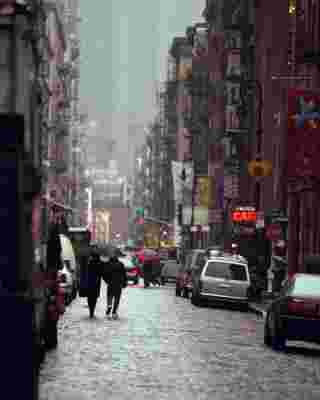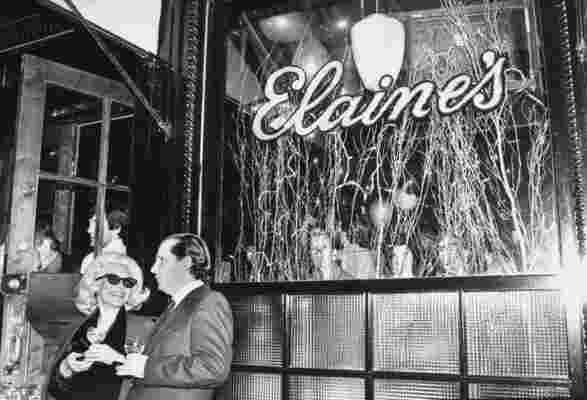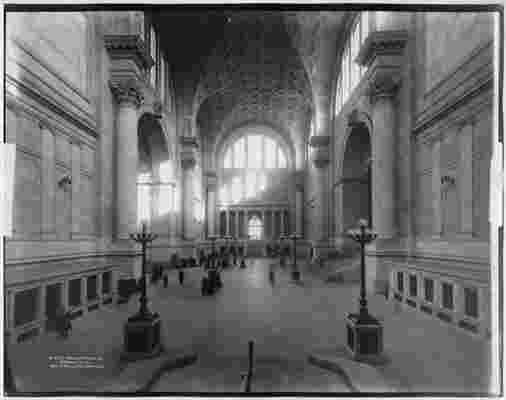Perhaps it’s New York City’s ability to transform itself so rapidly that makes those of us who love it so sensitive to the restaurant that closes, the hardware shop that shutters, or the building that comes down. Too often their replacements—shiny, new, shop-ified—seem to lack soul. For all its acclaimed verticality, Hudson Yards has drawn criticism that it isn’t much more than a glorified mall. CBGB decayed and was reborn as a John Varvatos boutique. Alphabet City has a Target. In Downtown Brooklyn, a skyscraper just went up complete with a rooftop pool. (Admittedly, the view is spectacular.) But even among those of us who appreciate convenience and style, there’s a wistfulness for the bygone Bohemian grit that emanated from certain neighborhoods.
The response to these overly polished, sterilized cityscapes is driving a new wave of urban nostalgia. Two recent New York Times features—one on capturing every block in the city in the 1980s , another recollecting the demolition of Penn Station —embody everything there is to love about seasoned urban architecture, especially as we see it disappearing. And then there is Jeremiah’s Vanishing New York blog, “a bitterly nostalgic look at a city in the process of going extinct,” run by Jeremiah Moss.

Mercer Street, in Manhattan's Soho, long before the arrival of the neighborhood's glitzy fashion boutiques.
Often nostalgia “gets a bad rap in our future-fetishistic current culture,” says Moss, a psychoanalyst who also authored the book Vanishing New York: How a Great City Lost Its Soul . But sentimentality may be healthy, he says. Empathic people tend to be less afraid of their own mortality, which he equates to this type of yearning. “People who do feel anxious about death tend to be bigger consumers—shopping and eating can soothe that anxiety.”
In his 2017 book, Moss (who writes under a pen name) predicted that Hudson Yards would be “a dreamworld of exclusion,” with rarified zombie shoppers Instagramming their way through a set of global clichés. He worries that urban landscapes—particularly public spaces—are becoming increasingly homogenized, overly tidy, and heavily commodified, leaving less room than ever for the unexpected qualities and encounters that generate a sense of place, those interactions that Jane Jacobs eloquently called a “sidewalk ballet.” That our eyes are glued to our smartphones while we walk through them probably doesn’t help.

The window of the now-shuttered, ever-popular Elaine’s restaurant, on the night of the party celebrating its 25 years in business, in 1988.
These are streets built for super-consumers, says Moss, and our pristine, new buildings literally and figuratively reflect us. On the other hand, he says, old, weathered buildings “remind us that we are mortal [and] vulnerable.” Demolishing brick and stone and replacing them with glass boxes, argues Moss, is a way of denying that vulnerability.
There have been other waypoints along the recent timeline of New York’s architectural nostalgia. The demolition of Penn Station in the mid-1960s has left many of us forever pining for McKim, Mead & White’s elegant arches and columns (even if the building had become decrepit and dysfunctional). The next two decades also dramatically changed neighborhoods and the city skyline. As municipal policies moved away from social democracy and increasingly incentivized corporate welfare and tourism, an era of gentrification began. (Hello, Trump Tower!) By the early aughts, New York itself was declared a “luxury product.”
By then, the terrorist attacks of September 11, 2001, had left another indelible mark on our collective psychology. Suddenly, the entire country was nostalgic for the World Trade Center’s Twin Towers, while New Yorkers began dissecting their emotional and physical relationships to the urban fabric.

The interior main waiting room of the now-leveled McKim, Mead & White–designed Penn Station in 1911.
“Our streets are calendars containing who we were and who we will be next,” writes Colson Whitehead in an iconic essay that same year. “Maybe we become New Yorkers the day we realize that New York will go on without us,” he goes on, achingly. “To put off the inevitable, we try to fix the city in place, remember it as it was, doing to the city what we would never allow to be done to ourselves.”
Change is inevitable, but how we build and rebuild our cities should be purposeful. “If we had a culture that valued compassion over consumption,” says Moss, “I believe we would have more old architecture, which can be more affordable and thus inclusive, and fewer soulless glass towers, which exclude many people.”
The Twin Towers at night on July 25, 1989.
If homogenized commodification of the built environment is worth resisting, a timely wave of nostalgia may be just the impetus we need to take up the fight. For inspiration, look to Long Island City, where organized protesters nullified Amazon’s entry into Queens. Interestingly, the borough holds the Guinness World Record for ethnic diversity .
So if you catch a glimpse of your fashionable self reflected in one of those shiny, new buildings, Starbucks in hand and AirPods in ear, stop and think, but be kind to yourself, too. As Whitehead wrote in his soulful tribute, “New York City does not hold our former selves against us. Perhaps we can extend the same courtesy.” Perhaps we can also build a city that is both discerningly modern and abundantly diverse economically, culturally, and architecturally. If any city can do it, surely it’s New York. And if an entire city can aspire to such goals, then surely you and I can order our next lattes from that local shop on the corner, instead of a globalized app.
